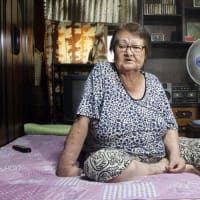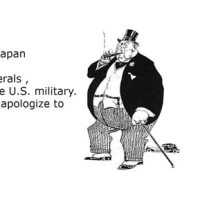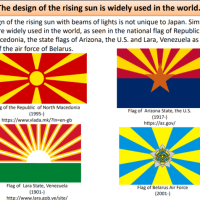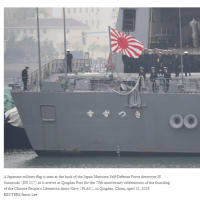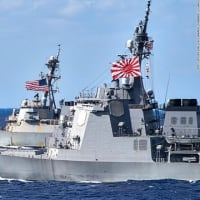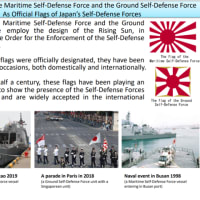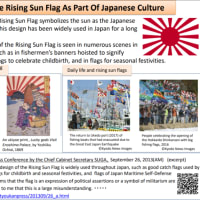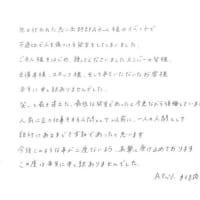Radiation levels and their effects on the food supply are explained in this videographic
わかりやすい。
Japan nuclear leak and tap water
Fergus Walsh | 17:48 UK time, Wednesday, 23
すでに紹介した。

How much radiation is too much radiation?
The Yomiuri Shimbun
- Thursday, March 24, 2011
Japan reactor leaks at faster rate than Chernobyl
DAVID McNEILL in Tokyo
How damaged nuclear plant's radiation gets into food, water
March 23rd, 2011
CNN's Thom Patterson, Elizabeth Landau, Danielle Dellorto, Miriam Falco, Madison Park and Jason Hanna contributed to this report
So far, risk low from radiation in food in Japan
(AP) – 2 days ago
ほとんどの専門家が現状では飲食品に関して、仮に、放射性物質が検出された飲食品を摂取してもかなりの量を長期間ーー例えば1年ーーー飲食し続けない限り健康への危険はかなり低い、ただ、妊娠した女性、乳幼児、授乳に関しては注意が必要、という点では一致している、と言えよう。
そのほか、水に関して、フィルター効果などや、放射線が検出されていない水と混ぜるなどのも紹介されている。
これは日本でも同様に紹介されている。例えば、
水道の放射性物質「活性炭フィルター浄水器」有効性ありか!?
2011/3/24
水道水もこれで大丈夫!汲み置いてペット水で割れば規制値以下
2011/3/24
注意すべきは、セシウムなど土壌→飼料→畜産、また、水→畜産、という連鎖を指摘し、、牛豚などの体内のセシウムが安定なレベルに達する数かけ月間は汚染されていない飼料を与えればよい、という指摘をしている。
日本でも対策を取り始めているようではある。
畜産農家 放牧の中止を
(秋田県)
山形県、24日から農畜産物の放射性物質検査
(2011年3月24日12時51分 読売新聞)
危険性について素人なので評価できる立場にはない。
しかし、
健康被害・風評被害を最小限にするには早め早めの対策が必要である。
日本の食品、あるいはその一部を輸入禁止する国もでてきている。
英語のコメント欄をみてもそうした不安が出されている。
関係ないと思っている地域でも早期に対策をこうじておいた方がいい。
正直で厳格、徹底した対策をとることは最初経済的な打撃はあるかもしれないが、長期的にみれば、信頼回復も早いだろう。誤魔化しが見つかると一気に信頼が失墜するのでその点も注意すべきである。
更新
水道水「妊娠・授乳中でも影響なし」 産科婦人科学会
2011年3月24日17時53分
乳児の指標100ベクレルとは?
わかりやすい。
Japan nuclear leak and tap water
Fergus Walsh | 17:48 UK time, Wednesday, 23
すでに紹介した。

How much radiation is too much radiation?
The Yomiuri Shimbun
- Thursday, March 24, 2011
Japan reactor leaks at faster rate than Chernobyl
DAVID McNEILL in Tokyo
Several radiation experts have also played down the impact of the radiation and its impact on the country’s food supply. “Perhaps if you were drinking 20 litres a day, in which case you’d die of water intoxication, it could be a problem,” said Robert Gale, a specialist in nuclear accidents.
Another radiation expert said this week that life one kilometre outside the restricted area surrounding a stricken Japanese nuclear plant leaking radiation was as safe as London.
“The people we should worry about . . . are those working at the site of the Fukushima Daiichi nuclear power plant,” said Prof Shunichi Yamashita, who advises the Fukushima government on radiation exposure. “Otherwise we do not have to worry about exposure.”
Some experts say public concern about the Fukushima crisis is distracting attention from the effort to help about half a million people left homeless by the huge March 11th earthquake and tsunami.
How damaged nuclear plant's radiation gets into food, water
March 23rd, 2011
CNN's Thom Patterson, Elizabeth Landau, Danielle Dellorto, Miriam Falco, Madison Park and Jason Hanna contributed to this report
What are the risks of consuming the food, milk and water?
Experts say little is known about how eating radiation-contaminated food affects people in the short- and long-term. But experts who have spoken with CNN say that the contamination levels reported so far appear to pose very little risk.
Dr. James Cox, an oncology professor at the MD Anderson Cancer Center in Houston, said he believes the radiation levels measured in these products pose a "nonexistent" immediate risk to humans, and "very low" long-term risk.
Spinach tested in a prefecture south of Fukushima showed radiation up to 27 times greater than the legal limit. Gupta, however, said a person "would have to eat the contaminated spinach from Japan every day for one year to get the same amount of radiation you would get from one chest CT (computed tomography) scan."
A chest CT scan would expose a person to about 7 millisieverts of radiation. The U.S. Nuclear Regulatory Commission says that an average person gets about 3.1 millisieverts annually from natural sources, and an average American - thanks in part to medical diagnostic procedures and other man-made sources of radiation - gets about 6.2 millisieverts per year.
Even low radiation doses can damage or alter the DNA of irradiated cells, the NRC says. And the radiation protection community "conservatively assumes that any amount of radiation may pose some risk for causing cancer and hereditary effect, and that the risk is higher for higher radiation exposures," the NRC says.
But Gupta and Moscovitch say it's highly unlikely that the radiation reported so far in Japanese food would pose a risk to human health.
"(The radiation is) not negligible my any means. But impact on human health? Not likely," Gupta said Wednesday night on the CNN program "In the Arena."
Read more about what Cox - an expert on the effects of radiation on the survivors of Nagasaki and Hiroshima - has to say about the risks in this story, which also addresses the consumption of contaminated milk following the Chernobyl nuclear disaster in 1986.
The concern about infants and the contaminated water
Tokyo officials recommended withholding tap water from infants after government samples taken Tuesday night found 210 becquerels of radioactive iodine per kilogram of water - two times higher than the limit that the government considers safe for infants.
The amount of iodine detected was lower than the level considered safe for adults: 300 becquerels per kilogram. A liter of water weights 1 kilogram. A becquerel is a measurement of radioactive intensity by weight.
The level set for infants is "very conservative," Cox said, but elevated radiation levels are considered a problem for small children, because their thyroid glands are more susceptible to radioactive iodine.
"Erring on the side of caution for the extreme degree for children makes good sense," Cox said. For adults, "as far as the immediate health risk, something that would make people sick, I don't think that would come close to it."
Can radioactive contamination be removed from water?
The World Health Organization says standard water treatment procedures - including coagulation, sedimentation and filtration - might remove "significant amounts of radioactive contaminants." Other options including blending contaminated water with noncontaminated water to dilute the radioactive particles, the organization says.
So far, risk low from radiation in food in Japan
(AP) – 2 days ago
Q: In what foods in Japan have these radioactive elements been found?
A: Iodine has been found mostly in milk and spinach, but also in chrysanthemum greens, leeks and a few other foods. Cesium also has been found in some vegetables. Levels found so far range from trace amounts to milk with iodine levels five times the acceptable limit, and in spinach, iodine levels 27 times the ceiling. Officials soon will test seafood.
Q: If you ate that, what would it mean?
A: You'd have to eat 2 pounds of the most contaminated spinach to absorb about as much radiation as you'd get from a CT scan of the head, says Dr. Clifford Chao, radiologist-in-chief at New York-Presbyterian Hospital.
People who drank milk with the highest measured levels of iodine for two weeks would absorb less than a year's worth of natural background radiation, according to a report from British environmental radiation group, Mike Thorne and Associates Ltd. But infants would absorb more than adults.
Q: What about breastfeeding?
A: Radioactive iodine could be in breast milk if nursing mothers in Japan were exposed; potassium iodide comes in doses for infants, too, if needed.
Q: How does radiation get into food anyway?
A: Fallout can land on crops in fields and wash into the soil to be soaked through the roots. Livestock can eat contaminated animal feed. It's possible seafood could be affected from contaminated water, although in the ocean "dilution would be huge," Mettler says.
Q: What about canned or other foods stored before the earthquake ― can residents eat that?
A: The WHO says radioactivity cannot contaminate sealed packaged foods, and that cropland can be covered with tarps and livestock brought into barns and fed clean feed.
Q: How long will radiation be a food threat?
A: Radioactive iodine decays quickly, with a half-life of eight days, meaning the length of time it takes for half of it to break down harmlessly. "In a couple of months, the iodine is a non-issue," says Mettler.
Cesium, however, can stay in soil for 30 years. But animals intended for slaughter can be given clean feed for a few months until cesium in their bodies drops to safe limits, he says. Also, the radiation stays only in the top inches of soil so deep plowing can make a field safe to use.
ほとんどの専門家が現状では飲食品に関して、仮に、放射性物質が検出された飲食品を摂取してもかなりの量を長期間ーー例えば1年ーーー飲食し続けない限り健康への危険はかなり低い、ただ、妊娠した女性、乳幼児、授乳に関しては注意が必要、という点では一致している、と言えよう。
そのほか、水に関して、フィルター効果などや、放射線が検出されていない水と混ぜるなどのも紹介されている。
これは日本でも同様に紹介されている。例えば、
水道の放射性物質「活性炭フィルター浄水器」有効性ありか!?
2011/3/24
水道水もこれで大丈夫!汲み置いてペット水で割れば規制値以下
2011/3/24
「今回検出された放射性ヨウ素131の半減期は8日。つまり8日たつと半分に減り、16日で4分の1になる。そこで考えてもらいたいのは、ペットボトルに水道水を詰め、栓をして保管すれば1日で約1割減っていく。それをミネラルウオーターで2倍に薄めれば放射性ヨウ素は100ベクトルを切ってしまう」
注意すべきは、セシウムなど土壌→飼料→畜産、また、水→畜産、という連鎖を指摘し、、牛豚などの体内のセシウムが安定なレベルに達する数かけ月間は汚染されていない飼料を与えればよい、という指摘をしている。
日本でも対策を取り始めているようではある。
畜産農家 放牧の中止を
(秋田県)
農林水産省では牛などの家畜に与えるエサについて、原子力発電所の事故が発生する前に刈り取った飼料のみを使うこと、牧草などの飼料はラップでくるむなどして大気に触れないようにすること、放射性物質に汚染されるおそれのあるわき水や流水を使わないこと、さらに当面のあいだ放牧を控えて畜舎のなかで飼育することなどを求めています
山形県、24日から農畜産物の放射性物質検査
(2011年3月24日12時51分 読売新聞)
危険性について素人なので評価できる立場にはない。
しかし、
健康被害・風評被害を最小限にするには早め早めの対策が必要である。
日本の食品、あるいはその一部を輸入禁止する国もでてきている。
英語のコメント欄をみてもそうした不安が出されている。
関係ないと思っている地域でも早期に対策をこうじておいた方がいい。
正直で厳格、徹底した対策をとることは最初経済的な打撃はあるかもしれないが、長期的にみれば、信頼回復も早いだろう。誤魔化しが見つかると一気に信頼が失墜するのでその点も注意すべきである。
更新
水道水「妊娠・授乳中でも影響なし」 産科婦人科学会
2011年3月24日17時53分
日本産科婦人科学会(日産婦)は24日、東京都の浄水場の水道水から基準を超える放射性物質が検出された問題を受け、妊婦や授乳中の母親への注意点を発表した。現状程度の放射性物質の濃度なら連日飲んでも母親にも赤ちゃんや胎児にも影響はないという。
日産婦によると、今回検出された数値よりも放射性物質の濃度が高い500ベクレルの水道水を、280日間の妊娠期間中に毎日飲んだ場合の被曝(ひばく)量は約4ミリシーベルトで、母乳に分泌される量はその4分の1程度。どちらも胎児に影響が出るとされている50~100ミリシーベルよりかなり低いとみる。
このため、日産婦は「現状では妊婦が毎日水道水を飲んでも母体にも胎児にも健康被害は起こらない」と判断した。ただし、汚染された水道水以外の飲み水を入手できるなら、その方がいいという。
日産婦は、妊婦が水分を十分に取らないと、胎児の健康にも悪影響が懸念されるとして、「のどがかわいた場合は決して我慢しないで水分を取って」と呼びかけている。
乳児の指標100ベクレルとは?
各地の水道水から乳児向けの飲用基準を超える放射性ヨウ素が検出されている。疑問点をまとめた。
Q 指標値は何を根拠に決めた?
A 乳児の水1キロ・グラムあたりの放射性ヨウ素の指標値は100ベクレル。乳児以外は300ベクレル。人工乳を使うと水の摂取が多くなることなどから、厚生労働省が別の指標を作った。いずれも1年間水を普通に飲んだ時に、健康に影響が出ない値を計算した。
Q 乳児とは何歳まで?
A 厚労省は、年齢に関係なく、主に乳児用粉ミルクを飲む年代の子どもを規制の対象にしている。
Q 乳児以外の子どもは大丈夫なの?
A 水1キロ・グラムあたり放射性ヨウ素300ベクレルという値は、大人と乳児以外の子どもの両方について健康への影響を計算してあり、問題ない。
Q 授乳中の母親はどうしたら良いか。
A 母乳に含まれる放射性ヨウ素は、母親が飲んだ水に含まれる量より少なく、乳児への影響は約3分の1に減る。厚労省では、授乳中でも大人の指標以下の水なら問題ないとしている。
Q 妊婦は大丈夫か?
A 大人の指標値ぎりぎりの水道水を妊娠期間中、毎日1リットル飲んでも、被曝
ひばく
量は胎児に影響が出る量の数十分の一で問題ない。妊娠中は脱水症状に注意が必要だ。我慢せずに水分をとりたい。
Q 水道水の保存はきく?
A 指標値を超えたのは、雨の影響もある。低い値が続いた時に、くみ置きしておくと良い。ただ、雑菌が繁殖しやすくなるので、何日もの保管は勧められない。
Q 浄水器や煮沸は効果があるの?
A 浄水場では活性炭で放射性物質を減らしているが、家庭用浄水器でも減らせるという確実な証拠はない。煮沸についてはかえって放射性物質の濃度が上がるのでよくないという専門家もいる。
(2011年3月24日22時36分 読売新聞)。










